The pressure is on!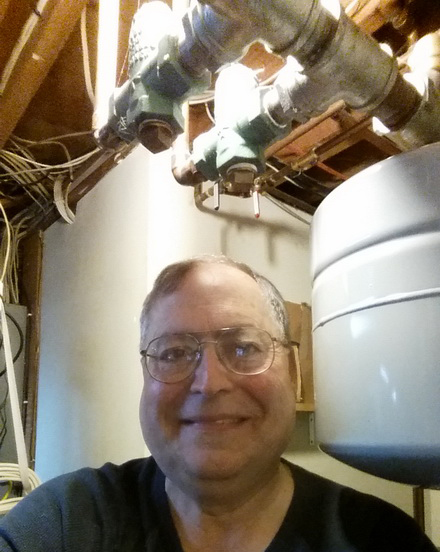
This is the next installment in the Swenton.COM DIY (Do-It-Yourself) tutorials. If you do not have the necessary skills please use a heating system contractor for repairs. Improper heating system repairs can cause dangerous conditions such as explosion, scalding burns, fires, hazardous spills and carbon monoxide poisioning.
Last week we noticed the hot water baseboard heating system suddenly became noisy. The noise was water bubbling sounds as the water traveled through the pipes and baseboards.
I noticed shortly thereafter that the system began venting air from the air purge valve and eventually the water bubbling noise dissipated. I found this event interesting since the system is closed-loop. That means I have the automatic fill shut off and the water pressure has been steady at 15 psi forever. So the big question is "Where did the air come from?" In retrospect, once I replaced the bad part everything was understood.
After all the air was purged and the noises stopped I thought everything was fine. Later I noticed the pressure had dropped to 10 psi. No problem, I thought. After the air was vented the pressure dropped normally so I added more water to increase the pressure back to 15 psi.
Checking back a few hours later the pressure had increased to 20 psi. This is not good. What caused the pressure increase? The automatic fill was shut off. I drained off some water to lower the pressure. Later on the pressure dropped even more. What was going on?
If there was a leak in the pipes or baseboards we should have seen evidence of water leaks or water damage in walls or ceilings. Nothing like this was observed.
In doing research I found that a hole in the domestic hot water heat exchanger could cause pressure changes. When you turn on the hot water the boiler water could be pushed into the hot water coil and drop the pressure. When you turn off the hot water the boiler pressure could increase as water is discharged from the coil and into the boiler. After some careful observations I observed that the boiler pressure remained constant if the house hot water faucets were off. This led me to believe there was no leak in the hot water heat exchanger.
The next thing to explore was the expansion tank. This is a metal tank roughly about a foot in diameter and a foot tall. It is typically installed on what is called an air scoop. The air scoop is a device that "scoops" air out of the water as it passes through the device. It is installed inline on the main boiler water line. An air vent valve is installed on top of the scoop. During operation the scoop will make any air in the water rise to the top of the scoop where the vent valve will discharge the air until water hits the valve. Then the valve will close. The expansion tank is usually installed an the bottom of the air scoop. The expansion tank is installed there for convenience. The scoop is only acting like a Tee as far as the tank is concerned. You really could put the tank anywhere but putting it on the air scoop eliminates the extra Tee.
The expansion tank is not just a simple tank. Inside the tank there is a rubber diaphragm installed midway in the tank. It is pressurised from the bottom of the tank to 12 psi. When the tank is installed and the system is pressurised the system water will enter the top of the tank and press against the pressurised diaphragm. If the system pressure matches the 12 psi tank pressure there will be no water in the tank. If the system water pressure is increased some water will enter the tank and press on the diaphragm.
The expansion tank acts like a regulator to moderate the system pressure. As the system water is heated it will expand. If the water has no place to go the system pressure will increase. If the expansion tank is installed the expanded water volume will go into the tank. As the system water cools the water will contract, the pressure will drop and the expansion tank diaphram pressure will push the water out of the tank and back into the system.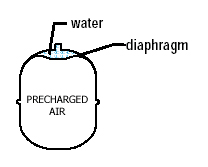 Here's a drawing of an expansion tank on a system with about 12 psi of pressure. If the precharged air pressure is 12 psi then little water will enter the tank.
Here's a drawing of an expansion tank on a system with about 12 psi of pressure. If the precharged air pressure is 12 psi then little water will enter the tank.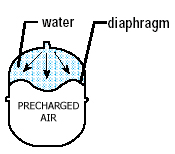 When the system water pressure rises more water will enter the top of the tank and press on the diaphram which will cause an increase in the precharged air pressure. The precharged air acts like a spring and helps regulate system pressure by expanding and compressing as needed.
When the system water pressure rises more water will enter the top of the tank and press on the diaphram which will cause an increase in the precharged air pressure. The precharged air acts like a spring and helps regulate system pressure by expanding and compressing as needed.
I got my tire pressure gauge, removed the protective cap on the expansion tank and proceeded to check the precharged air pressure. Normally you check this pressure with the system depressurized. You expect to see about 12 psi. When I used the tire pressure gauge to test the tank water gushed out of the test valve! This is a dead give-away that the expansion tank diaphram has ruptured and the whole tank is full of water. This also explains the air that was mysteriously introduced into the system and why no more air got in after the initial event.
I ordered a new expansion tank on Amazon for about $45.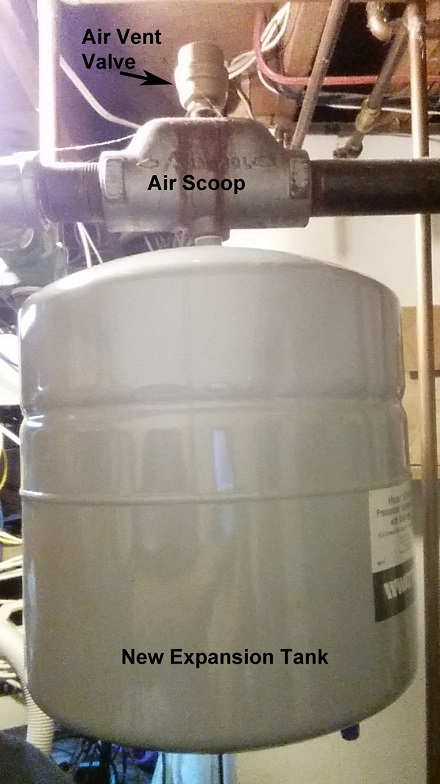 Here's a picture of the new tank installed on the bottom port of the air scoop. You can see the air scoop above the tank and the air vent valve on the top port of the air scoop.
Here's a picture of the new tank installed on the bottom port of the air scoop. You can see the air scoop above the tank and the air vent valve on the top port of the air scoop.
During my testing with the bad tank the pressure got too high and the safety relief valve operated to release the excess pressure. This is not a bad thing as it is working as desiged. Unfortunately once those valves operate once there is a good chance that it will not reseal well. Mine was dripping until I manually operated the valve several times. It is aleays a good idea to replace this valve after a release event.
I ordered a new relief valve on Amazin for about $35.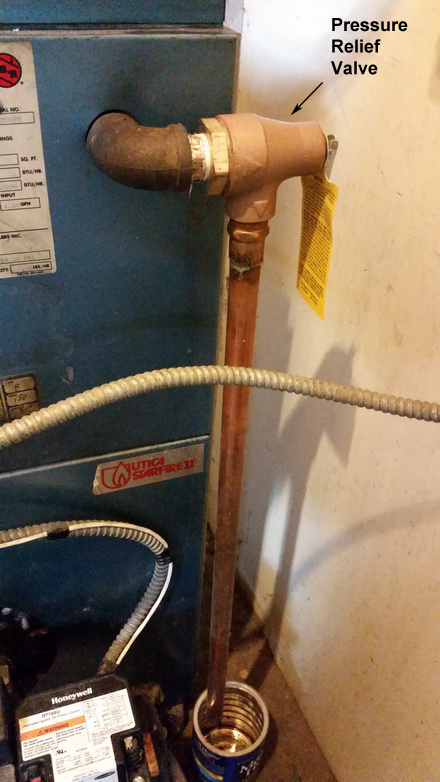 Here's a picture of the new pressure relief valve. Because this valve will discharge 180 degree water you need to have that pipe going toward the floor to keep people from getting scalded. I like to put a can under the pipe so I can detect if the valve ever starts leaking.
Here's a picture of the new pressure relief valve. Because this valve will discharge 180 degree water you need to have that pipe going toward the floor to keep people from getting scalded. I like to put a can under the pipe so I can detect if the valve ever starts leaking.
During my work I noticed the backflow preventer was dripping. I had to shut the house water off to replace some faucet washers. After I turned the water back on the backflow preventer started to drip very slowly. Since I was going to be depressurising the boiler it is a good time to replace this too.
The backflow preventer allows water to go from the house and into the boiler but not the other way. It prevents boiler water from being sucked into the house water should the house water pressure drop to below the boiler pressure.
I ordered a new backflow preventer on Amazon for about $45.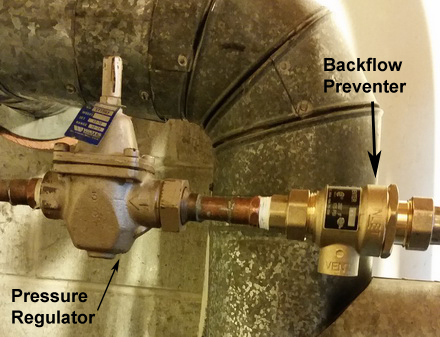 Here's a picture of the newly installed backflow preventer. The house cold water enters on the left where the backflow preventer has "Inlet" stamped on its body. The pressure reguator is set to 15 psi so that the 80 psi house water pressure won't over-pressurize the boiler.
Here's a picture of the newly installed backflow preventer. The house cold water enters on the left where the backflow preventer has "Inlet" stamped on its body. The pressure reguator is set to 15 psi so that the 80 psi house water pressure won't over-pressurize the boiler.
The three new parts arrived today and were easily replaced. Here's a picture of the pressure/temperature gauge. The top half of the display is showing about 16 psi of pressure. The bottom half is showing 180 degrees F water temperature.
Here's a picture of the pressure/temperature gauge. The top half of the display is showing about 16 psi of pressure. The bottom half is showing 180 degrees F water temperature.
So that's it. Simple fix. Not too expensive. It was about $125 for the parts. The expansion tank was the main fix. The backflow preventer was dripping and was unrelated to the pressure problem. The pressure relief valve was replaced as a proactive measure. These new parts should last a good 15 to 20 years.
Site Content
Heating System Woes 2015
- Details
- Category: Appliance Repair
- Hits: 2190



